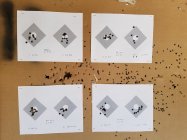I have a 308 r700 with 24" 5R barrel and the HS Precision fiberglass stock, all original except for timney 2 stage trigger. Roughly 1360 rounds total. I'm loading large primer lapua brass with 168 Berger hybrids and Vld's with 46.5-47.5 grains of cfe223. By the books that is barely a starting load, yet I get well over 2800 fps on the Labradar. I have also tried Varget and 8208, but cfe223 gives me 100-150 fps more and meters a lot better. I have tried oal's from 2.800 to 2.870 with seemingly no change in accuracy or pressure. It has surprisingly long freebore, considering the twist is only 11 1/4. For case prep, I sort by weight, +- .5 grain, with a light neck turn. I decap and neck size on a rock chucker, then prime, powder, and seat on a Dillon xl750 with dillon seat die. Runout is typically 0 to .010 at the tip. For load development I weigh every charge on a dillon electronic scale.
My problem is inconsistency in the numbers. One group of 5 will show es of 14, sd of 8, then the next 5 will be something like 44 and 23. I have tried Rem 9-1/2, 9-1/2M, and Fed 210 primers. I saw identical velocities between the two rem primers, but they were both good for about 50fps more than the Fed primers.
Questions -
Would 10 shot groups be worth the effort for more reliable data? If so, how do you go about a 10 shot group to control barrel temp?
Reloading books used to recommend magnum primers with ball powders like blc2 and 748. Is cfe223 harder to light?
I have a deal pending for CCI LR Benchrest primers. I will also try Fed 215's when I can find some. How do you guys rank primers for consistent es and sd?
scott
My problem is inconsistency in the numbers. One group of 5 will show es of 14, sd of 8, then the next 5 will be something like 44 and 23. I have tried Rem 9-1/2, 9-1/2M, and Fed 210 primers. I saw identical velocities between the two rem primers, but they were both good for about 50fps more than the Fed primers.
Questions -
Would 10 shot groups be worth the effort for more reliable data? If so, how do you go about a 10 shot group to control barrel temp?
Reloading books used to recommend magnum primers with ball powders like blc2 and 748. Is cfe223 harder to light?
I have a deal pending for CCI LR Benchrest primers. I will also try Fed 215's when I can find some. How do you guys rank primers for consistent es and sd?
scott











